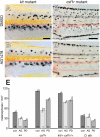Embryonic requirements for ErbB signaling in neural crest development and adult pigment pattern formation
- PMID: 18508863
- PMCID: PMC2704560
- DOI: 10.1242/dev.019299
Embryonic requirements for ErbB signaling in neural crest development and adult pigment pattern formation
Abstract
Vertebrate pigment cells are derived from neural crest cells and are a useful system for studying neural crest-derived traits during post-embryonic development. In zebrafish, neural crest-derived melanophores differentiate during embryogenesis to produce stripes in the early larva. Dramatic changes to the pigment pattern occur subsequently during the larva-to-adult transformation, or metamorphosis. At this time, embryonic melanophores are replaced by newly differentiating metamorphic melanophores that form the adult stripes. Mutants with normal embryonic/early larval pigment patterns but defective adult patterns identify factors required uniquely to establish, maintain or recruit the latent precursors to metamorphic melanophores. We show that one such mutant, picasso, lacks most metamorphic melanophores and results from mutations in the ErbB gene erbb3b, which encodes an EGFR-like receptor tyrosine kinase. To identify critical periods for ErbB activities, we treated fish with pharmacological ErbB inhibitors and also knocked down erbb3b by morpholino injection. These analyses reveal an embryonic critical period for ErbB signaling in promoting later pigment pattern metamorphosis, despite the normal patterning of embryonic/early larval melanophores. We further demonstrate a peak requirement during neural crest migration that correlates with early defects in neural crest pathfinding and peripheral ganglion formation. Finally, we show that erbb3b activities are both autonomous and non-autonomous to the metamorphic melanophore lineage. These data identify a very early, embryonic, requirement for erbb3b in the development of much later metamorphic melanophores, and suggest complex modes by which ErbB signals promote adult pigment pattern development.
Figures












References
Publication types
MeSH terms
Substances
Grants and funding
LinkOut - more resources
Full Text Sources
Medical
Molecular Biology Databases
Research Materials
Miscellaneous

